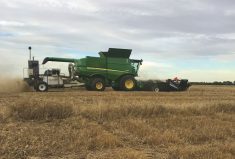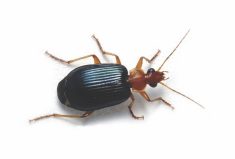A new alien is lurking in the fields of North Dakota and Minnesota, preparing to invade Canada and cause no end of trouble.
The potential enemy is a noxious weed called waterhemp, a member of the pigweed family and a cousin of Palmer amaranth, a glyphosate-resistant weed currently plaguing cotton and soybean growers in the southern United States. Like its pesky southern relative, waterhemp is increasingly resistant to glyphosate. And like other weed pests, its growing presence in the U.S. means it’s likely to eventually cross the 49th parallel. In fact, it has already been reported at Cando, N.D. just an hour’s drive south of the Manitoba border.
Read Also

Sensing the soil: Root cell research finds ‘stress hormone’
Research into how root cells react to soil stressors could help plants better adapt to changes in their climate.
“It just seems to be growing and growing and moving north every year,” says Richard Zollinger, a North Dakota State University extension weed specialist in Fargo.
As happened with the varroa mite, zebra mussels, soybean cyst nematode and other invasive species which originated in the U.S., waterhemp will ultimately make its way into Canada.
“It’s probably not ‘if ’ we get the weed. It’ll be ‘when.’ So we should be prepared,” says Jeanette Gaultier, a Manitoba Agriculture, Food and Rural Development weed specialist.
Just how much damage waterhemp could do to Canadian crops is unknown. But Zollinger’s research is far from reassuring. His surveys show waterhemp is capable of reducing corn and soybean yields by anywhere from 15 to 44 per cent.
“There are fields in North Dakota where you can hardly find a soybean, it’s so thick,” Zollinger says.
As its name implies, waterhemp likes wet conditions to germinate and grow in. Northern U.S. states have been in a wet cycle for several years, encouraging the spread of waterhemp seeds overland and along major waterways such as the Red River. Although there are other ways of spreading the seeds (e.g. by machinery), high water and overland flooding are the main methods.
In Manitoba, the situation is similar. “We’ve been in a very wet cycle. We do have the same flooding issues. We’re going to see that plant here at some point,” says Gaultier.
Besides being water-borne, another reason for waterhemp’s rapid spread is its heavy seed set. Studies show waterhemp can produce more than a million seeds per plant. Zollinger says scientists have detected up to five million seeds per plant in some cases.
Yet another reason is the weed’s unique biology. The male and female flowers are on separate plants (a characteristic known as dioecious). The male plants produce pollen and the female plants make the seed. This outcrossing creates huge genetic diversity, which can produce biotypes resistant to certain classes of herbicides, including glyphosate.
The classic reason for glyphosate resistance is the continuous use (and overuse) of glyphosate, especially on Roundup Ready crops such as sugar beets, corn, soybeans, cotton and canola. It’s hardly surprising that glyphosate resistance is on the rise in North Dakota and Minnesota, since the first three crops are grown extensively there. That’s particularly true for soybeans, which are expanding rapidly in those states as the American soybean belt moves gradually northward. Zollinger says North Dakota now has the fourth-largest soybean acreage in the U.S. behind Iowa, Indiana and Minnesota. It is also the fifth-largest in total production.
Compare that to Manitoba, where, within the last 10 years, soybeans have grown to become the third-largest crop in the province behind wheat and canola. Nearly all those soybeans are glyphosate tolerant. With soybeans increasing in popularity, the last thing growers in the Keystone province want is a new glyphosate-resistant weed.

Multiple resistance
It’s not just glyphosate, either. Zollinger says waterhemp in some U.S. states is also starting to exhibit resistance to other classes of herbicides, including Group 2 ALS/AHAS inhibitors.
“Every population that would appear in Canada would be ALS Group 2 and glyphosate resistant,” Zollinger says.
Although it is a pigweed, waterhemp is a summer annual that germinates much later than other pigweed species, from mid-June to July. Zollinger says flushes can appear as late as August. A herbicide application may control the first flush, but any sunlight getting into the crop as the season progresses will stimulate new flushes. Waterhemp is a tall weed and, once established, competes well with annual crops. Herbicides tend to work best on weeds when they are small, and can be less effective on tall ones. So controlling waterhemp is a never-ending battle during the growing season.
Zollinger says glyphosate-resistant weeds such as waterhemp are a growing economic problem in North Dakota and Minnesota. To control them, producers have to double or even triple their herbicide costs. Although resistance makes fewer post-emergent options available, growers are slow to adopt pre-emergent herbicides because they are expensive and commodity prices aren’t as high as they were a few years back.
Getting ready
So what should farmers do to prepare for waterhemp’s arrival?
Gaultier encourages growers to get to know waterhemp’s biology, scout fields and monitor them for signs of a weed that looks different. Identifying waterhemp in its early stages can be difficult because most pigweeds appear similar at the seedling stage. However, Gaultier says the cotyledons of waterhemp are a little smaller than redroot pigweed and the leaves tend to be longer and more lance-shaped than other members of the pigweed family.
Zollinger agrees surveillance is key to stopping waterhemp before it spreads. He encourages farmers to map their fields and identify weed patches.
“Sitting on a combine is the perfect place to map your fields. If you see some areas where waterhemp is in patches, that is where you can concentrate your herbicides. You can map the fields and, in the coming spring, put on appropriate herbicides.”
Zollinger urges producers to exercise both crop and herbicide rotations to keep waterhemp in check. Wheat is an early emerging crop and its canopy can help limit flushes. Wheat and other cereals also offer options for herbicides that are not available for genetically modified corn and soybeans.
Then if you do spot a few waterhemp plants from the cab, get out and pull them up. If you have a field-full in three years, you’ll wish you had.
It’s an open question if waterhemp could spread to other parts of Western Canada. Gaultier says it prefers wet conditions, such as in the eastern Prairies. But Gaultier says waterhemp appears able to adapt to different conditions, so don’t be complacent.
“I wouldn’t recommend that folks further west be any less vigilant in their scouting than folks in the Red River Valley.”















